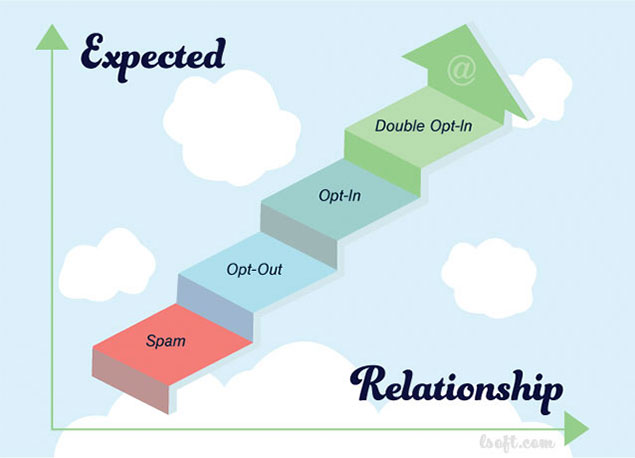Email Marketing: Levels of Permission
Permission to send email to your subscribers comes in many forms, ranging from weak to strong. Obtaining permission, or consent, is a necessary foundation for communication that people want and expect to receive on a continuous basis. It's easy to see why giving people power over the email messages that they receive has a positive impact on the relationship between senders and subscribers.
Levels of Consent
The graphic above illustrates the levels of email permission from none, to weak, to strong. Consent obtained through double opt-in builds a strong foundation for email marketing. When email messages are expected, the sender-subscriber relationship is active and strong.
 Strong Permission: Double Opt-In, Also Known as Confirmed Opt-In
Strong Permission: Double Opt-In, Also Known as Confirmed Opt-In
The strongest form of subscriber consent is indisputable, informed, specific, explicit and actively given. Double opt-in permission, which is also referred to as confirmed opt-in, is the most commonly used practice that email senders use to achieve this. As its name implies, it requires two action steps for a subscriber to join an email list: signing up an email address and then confirming that same email address by clicking a link in a confirmation message to activate the email list subscription. The EU GDPR requires verified consent, and double opt-in is an efficient way to obtain that verification.
 Weak Permission: Single Opt-In
Weak Permission: Single Opt-In
Single opt-in is not as strong or recommended type of permission as double opt-in, yet it's still a form of obtaining subscriber consent. With single opt-in, an active signup is required, but the address is not confirmed to belong to the person who submitted it. Sending a welcome email message confirming the signup and providing an unsubscribe link in that message is helpful to strengthen this opt-in method. This way the recipient can quickly notice if someone else submitted her or his email address and can unsubscribe with a click.
 No Permission: Opt-Out
No Permission: Opt-Out
The opt-out approach means that the sender assumes the right to send email until the recipient opts out by unsubscribing from future mailings. This is legal in some countries, for example in the United States under the CAN-SPAM act. However, recipients do not expect and in many cases do not want commercial bulk messages. Such messages contribute to in-box clutter, waste resources and are illegal in many countries, including Australia, Canada and the European Union.
Many email service providers (ESPs) prohibit the use of external sources of email addresses, for example purchased or rented email lists from a third party. The consensus is that it's a bad email practice. It results in low deliverability, high bounce rates, low response rates and also damages the sender's and the ESP's reputation. A specific, explicit, opt-in email address is simply not an easily transferable trading commodity. Behind every email address is a person who deserves to only receive the email that they have expressly asked to receive from a trusted source. Would you like someone to sell your email address? Probably not.
What about all the leads collected, for example at a conference? Companies can send opt-out email marketing messages to addresses that they collected themselves but without specific prior consent only in the countries where this practice is still legal, like in the United States. The stronger the assumed permission by way of a customer relationship, the better. All things considered, with the ever-changing legal framework, companies need to pay more attention to shifting from opt-out mailings to opt-in ones, even in the United States.
 Illegal: Spam
Illegal: Spam
Spam, junk mail or unsolicited email is the clearest case of zero prior permission from a recipient. This type of mass email communication generally violates applicable laws. There is no relationship between sender and subscriber or trust to build on. In short, never do this.
Permission is Just a Start

Permission can be seen as perishable goods, with an ingredient list and a date stamp. If the permission is weak to begin with or the messages not valuable, they can remain unopened or get deleted without being read. Even the strongest permission can fade if you don't deliver what you build expectations for and nurture it well.
The power of permission is that it constitutes a relationship – you reach people who want to hear from you. It is your recipients who have the power to join, stay and leave, and perhaps rejoin your mailing lists again later.
So choose to work with double opt-in from the start, and you will have a strong permission-based email list. Then make your email content match your subscribers' expectations with value.
LISTSERV is a registered trademark licensed to L-Soft international, Inc.
See Guidelines for Proper Usage of the LISTSERV Trademark for more details.
All other trademarks, both marked and unmarked, are the property of their respective owners.




 Strong Permission: Double Opt-In, Also Known as Confirmed Opt-In
Strong Permission: Double Opt-In, Also Known as Confirmed Opt-In
 Weak Permission: Single Opt-In
Weak Permission: Single Opt-In No Permission: Opt-Out
No Permission: Opt-Out Illegal: Spam
Illegal: Spam

